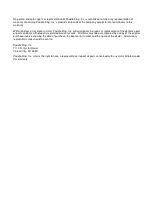
•
CO in engine exhaust from your boat can accumulate within enclosed areas when your boat is operating at
slow speed or stopped in the water. Although Paddle King Lo Pros are not available with side, rear or front
curtains, please be aware that these things, if added, can increase the possibility of CO accumulation in
your boat.
Lanyard Stop Switch:
This safety device is supplied by the manufacturer of the engine. Please refer to the owner’s
manual for detailed information about this switch.
The lanyard stop switch should never be removed or modified and should be kept free of anything that could
interfere with its intended operation.
This safety device will stop the engine if the boat operator falls or moves away from the control area. The clip is
usually secured to the operator’s clothing, arm or leg.
In order for the engine to run, the lock plate on the end of the lanyard must be attached to the engine stop switch.
To reset the switch after the engine was shutdown, reinstall the switch slip above the interrupter switch and slip the
interrupter switch.
Water Sports:
Your Lo Pro was not intended nor tested to pull a water skier, knee-boarder, or any other type of
rider of any type of pull-behind or inflatable apparatus. Any attempt of using your Paddle King product in doing so
should be at your own risk.
IX. Trailering
Proper trailer selection is essential for safe towing, loading and unloading your boat. Setup of your boat onto the
trailer is also very important. Improper trailering is one of the major causes of damage to your pontoon tubes. Your
pontoon must be well supported to prevent any damage. A bunk trailer or a mechanical folding trailer should
support the entire length of the tubes, therefore supporting the entire weight of your pontoon. Paddle King will not
be held liable for any damages caused by improper trailer setup or operation.
Gross Vehicle Weight Rating (GVWR):
Check your trailer’s frame for the GVWR. The total weight of your boat,
engine, and anything on the boat such as fuel, battery, gear AND trailer should not exceed the GVWR.
Weight Distribution:
If your towing vehicle is equipped with a weight distribution hitch, it must be capable of
handling the GVWR. The weight on the trailer should be evenly distributed and can be checked by determining the
tongue weight.
Tongue weight is a percentage of the total weight of the loaded trailer on its tongue. Ideal tongue weight is not less
than five percent (5%) and not more than ten percent (10%) of the GVWR. For example, if the weight of the loaded
trailer is 3000 pounds (1361 kg), the weight on the tongue should be more than 150 pounds (68 kg), but less than
300 pounds (136 kg). Excessive tongue weight causes the front end of the towing vehicle to sway. Insufficient
tongue weight causes the trailer to sway or fishtail.
To avoid person injury and property damage, be sure to balance the load when trailering. If too much weight rests
on the hitch, the front end of the vehicle will sway or over steer. Insufficient weight on the trailer causes the trailer to
fishtail. In either case, the vehicle will be hard to handle and could become uncontrollable at high speeds.
State regulations usually require that trailers above a specified weight rating be equipped with brakes.
Requirements vary; check with your dealer for additional information.
Hitch:
Hitches are divided into classes that specify the gross trailer weight (GTW) and the maximum tongue weight
for each class. Always use a hitch with the same class number as the trailer. Most boat trailers connect to a ball
hitch that is bolted or welded to the towing vehicle. Special heavy-duty equalizing hitches are necessary for trailer
tongue weights of 350 pounds (158 kg) or greater.
The trailer hitch coupler must match the size of the hitch ball. The correct ball diameter is marked on the trailer
coupler.
Summary of Contents for Lo Pro Cruiser
Page 23: ......






































